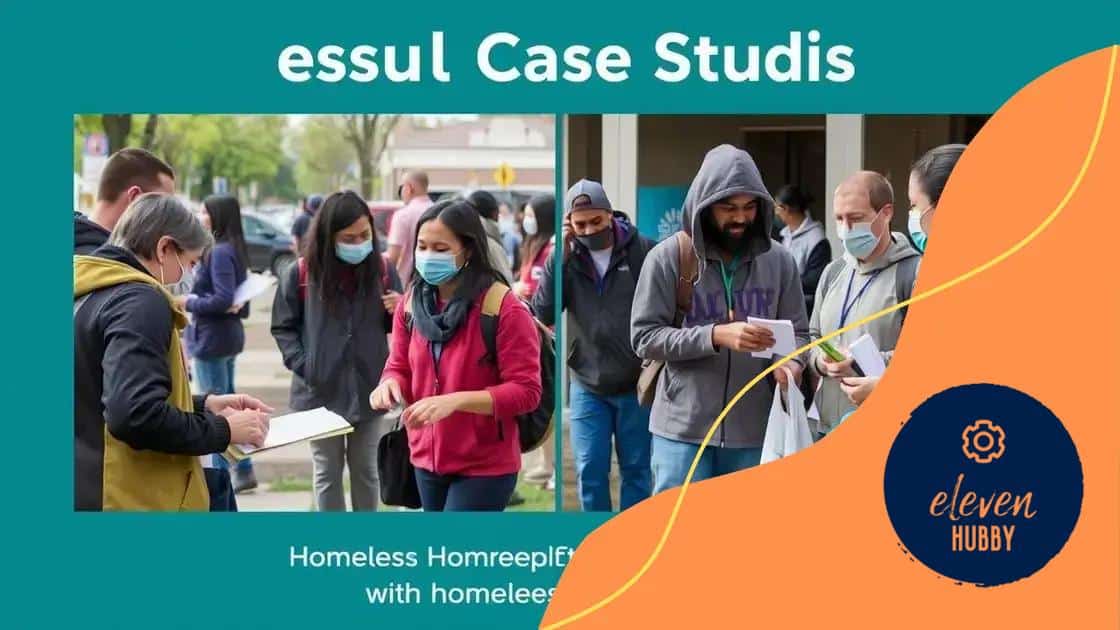Social welfare programs targeting homeless populations: what works?

Social welfare programs targeting homeless populations focus on providing essential resources like housing, mental health services, and job training, while facing challenges such as funding limits and societal stigma, but future trends indicate a shift towards technology and prevention strategies.
Social welfare programs targeting homeless populations play a crucial role in addressing the needs of some of the most vulnerable members of society. Have you ever considered how these initiatives can transform lives and communities? Let’s dive into this important topic.
Understanding homelessness and its causes
Understanding homelessness requires a closer look at the various causes behind this pressing issue. It’s crucial to recognize that homelessness isn’t just about the lack of housing; it’s a complex problem influenced by several factors. Many individuals and families find themselves in this situation due to economic hardship, mental health issues, or even unexpected life events.
Economic Factors are one of the primary reasons many people experience homelessness. With rising housing costs and stagnant wages, many struggle to afford basic living expenses. This situation often leads to evictions and eventual homelessness.
Life Events Contributing to Homelessness
Life can be unpredictable, and sometimes it throws challenges that people cannot manage alone. Events like job loss, divorce, or the death of a loved one can push individuals into homelessness. Many are just one paycheck away from being in crisis.
Mental Health and Substance Abuse
Mental health issues and substance abuse are significant contributors to homelessness. Unfortunately, many individuals do not receive the support they need. Treatment options may be limited, leading to a cycle of instability.
- Limited access to healthcare
- Stigma surrounding mental illness
- The need for comprehensive rehabilitation programs
As we delve deeper into understanding homelessness, we see that it’s a multifaceted problem that requires comprehensive solutions. It’s vital to address the underlying issues and provide the support and services that help prevent individuals from falling into homelessness.
Key components of successful welfare programs
When discussing welfare programs for homeless populations, it is essential to identify the key components that contribute to their success. These components are designed to address various needs and challenges that homeless individuals face daily.
Comprehensive Support Services
Successful programs often include a range of comprehensive support services. These services may encompass not only housing but also access to healthcare, job training, and mental health assistance. By offering multiple forms of support, these programs can effectively assist individuals in transitioning to stable living conditions.
Immediate Housing Solutions
A critical component of effective welfare programs is the provision of immediate housing solutions. Rapid rehousing initiatives have shown great promise, as they allow individuals to move directly into stable housing without lengthy wait times. This leads to better outcomes for those in need.
- Short-term housing options
- Emergency shelters
- Long-term housing strategies
Furthermore, the implementation of partnerships with local organizations enhances the reach and effectiveness of these welfare programs. Collaborations between government agencies, non-profits, and community groups create a network that increases available resources.
Finally, ongoing evaluation and feedback mechanisms play a vital role in successful program implementation. Regular assessments allow programs to adapt and improve based on the changing needs of homeless populations. This responsive approach ensures sustainability and effectiveness over time.
Case studies of impactful initiatives

Exploring case studies of impactful initiatives can provide valuable insights into what works well in addressing homelessness. These real-life examples highlight the effectiveness of targeted programs and innovative solutions that make a difference.
Successful Initiative in City A
In City A, a program known as “Housing First” has shown remarkable results. This approach prioritizes providing homeless individuals with stable housing without preconditions such as sobriety or employment. Once housed, participants receive support services tailored to their needs.
Community Support and Resources
This initiative emphasizes the importance of community support. Local organizations collaborate to offer mental health services, job training, and addiction recovery programs, ensuring that individuals have the tools they need to succeed.
- Increased housing stability
- Stronger community partnerships
- Empowerment through supportive services
Another inspiring example can be found in City B, where a mobile outreach program has evolved. This initiative sends teams into neighborhoods to connect with homeless individuals, offering immediate assistance and resources. By meeting people where they are, this program has significantly improved access to essential services.
These case studies illustrate that well-structured initiatives that focus on collaboration, support, and immediate solutions can lead to sustainable change in the lives of homeless populations.
Challenges faced in implementation
Implementing welfare programs for homeless populations involves navigating several challenges that can hinder their effectiveness. Understanding these obstacles is crucial to creating solutions and improving services.
Funding Limitations
One major challenge is the lack of adequate funding. Many programs rely on government support, but budgets are often tight. Limited financial resources can restrict the scope of services offered, making it difficult to meet the diverse needs of homeless individuals.
Policy and Bureaucratic Barriers
Additionally, complicated policies and regulations can slow down the implementation process. Navigating these bureaucratic hurdles requires time and expertise, which can drain valuable resources from programs that need to focus on direct assistance.
- Slow approval processes
- Inflexible regulations
- Coordination between agencies can be cumbersome
Another significant barrier is the stigma surrounding homelessness. This stigma can affect public perception and support for welfare programs. When people view homelessness as a personal failure rather than a societal issue, it becomes harder to rally community support and secure funding.
Moreover, engaging the homeless population itself can be challenging. Many individuals may be hesitant to seek help due to previous negative experiences or distrust of institutions. Outreach efforts must be sensitive and tailored to build rapport and trust.
Future trends in social welfare programs
As we look ahead, understanding the future trends in social welfare programs is essential. These trends reflect shifts in societal needs and advances in technology that can reshape how we address homelessness.
Increased Use of Technology
One major trend is the increased use of technology in service delivery. Many organizations are adopting digital platforms to streamline access to resources. Mobile apps and online portals allow individuals to find services quickly and manage their needs more efficiently.
Data-Driven Solutions
Data-driven approaches are also becoming more important. By analyzing data on homelessness, organizations can better understand the needs of their communities. This information helps in tailoring programs to address specific issues, leading to more effective outcomes.
- Real-time resource allocation
- Enhanced targeting of services
- Informed policy-making
Another trend is the focus on prevention strategies. Programs are moving from merely providing emergency services to addressing root causes of homelessness. This shift includes integrating mental health support and education into welfare initiatives, aiming to reduce the risk of homelessness before it occurs.
Collaboration between different sectors will also grow. As the complexity of homelessness issues increases, partnerships among government, non-profits, and private entities will become vital in creating comprehensive solutions. Together, they can leverage resources and expertise to provide holistic support.
In summary, social welfare programs targeting homeless populations face various challenges but also show promising trends for the future. By embracing technology and collaborating across sectors, these programs can become more effective. Focus on prevention, data-driven solutions, and comprehensive support will be key to reducing homelessness. As communities work together, they can create impactful initiatives that provide lasting help to those in need.
FAQ – Frequently Asked Questions about Social Welfare Programs
What are social welfare programs targeting homeless populations?
These programs provide assistance and resources to individuals experiencing homelessness, focusing on housing, mental health services, and job training.
How do technology and data enhance welfare programs?
Technology helps streamline resource access, while data-driven approaches allow organizations to tailor services to meet specific community needs.
What are some challenges these programs face?
Challenges include funding limitations, bureaucratic hurdles, and the stigma associated with homelessness, which can affect public support.
What future trends are emerging in social welfare programs?
Future trends include increased collaboration among sectors, a focus on prevention strategies, and the use of technology to improve service delivery.






